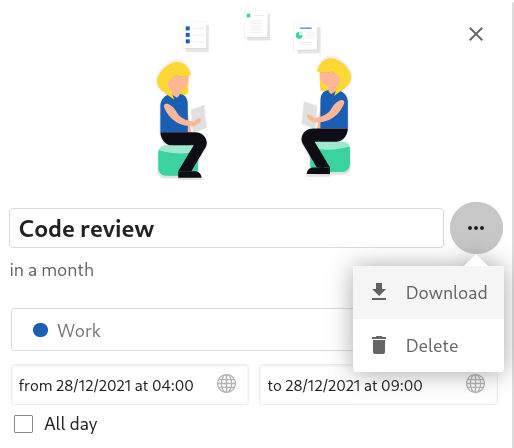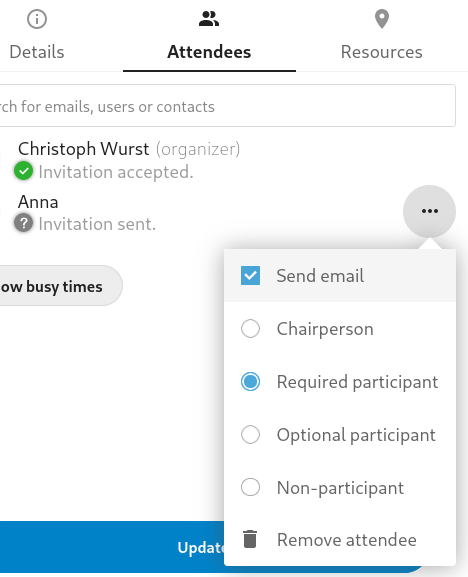Using the Calendar app
Notitie
The Calendar app comes installed with Nextcloud Hub by default, but can be disabled. Please ask your Administrator for it.
The Nextcloud Calendar app works similar to other calendar applications you can sync your Nextcloud calendars and events with.
When you first access the Calendar app, a default first calendar will be created for you.
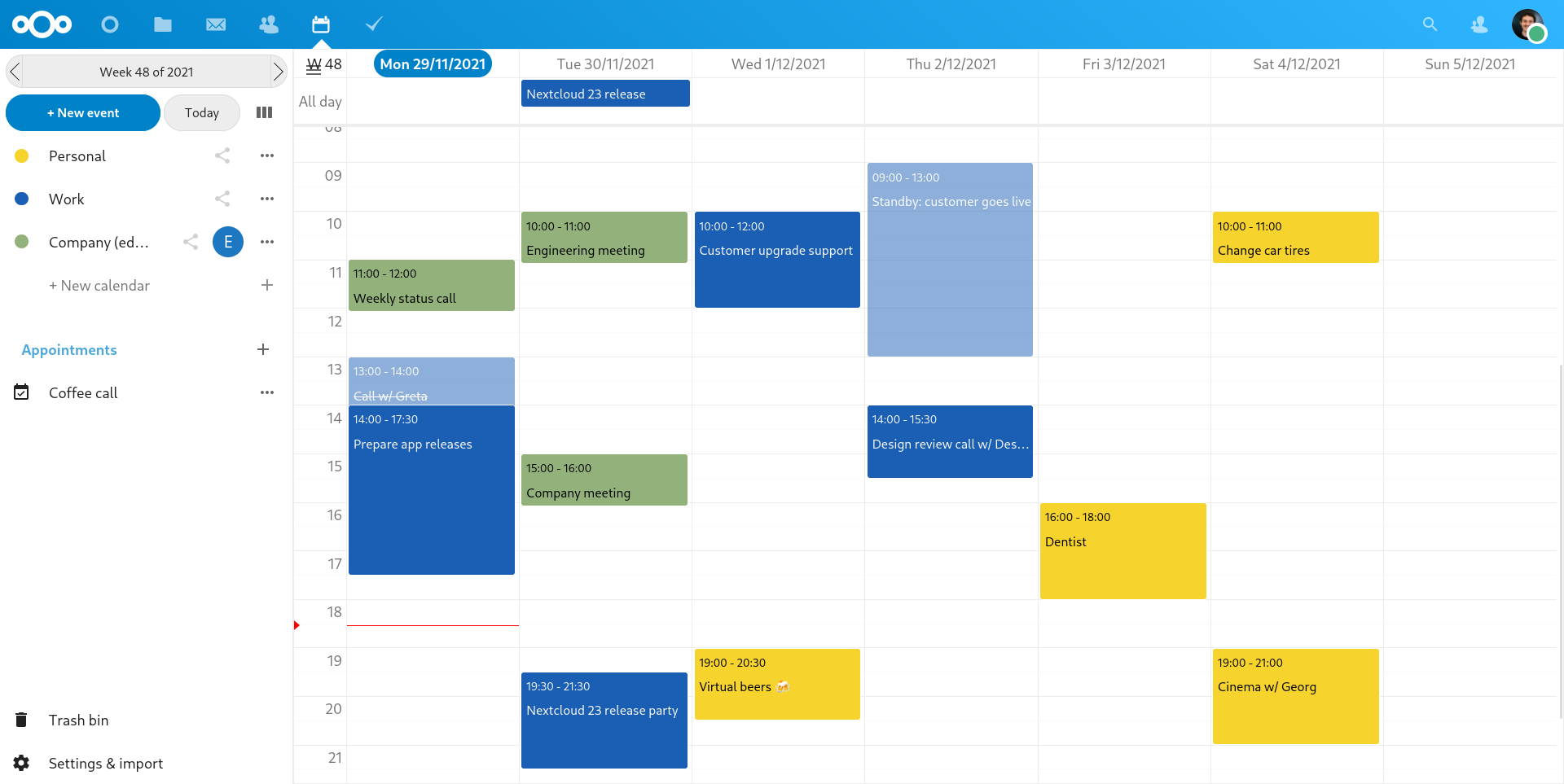
Managing your calendars
Create a new Calendar
If you plan on setting up a new calendar without transferring any old data from your previous calendar, creating a new calendar is the way you should go.
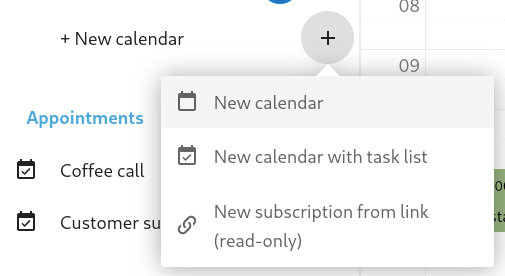
Click on
+ New Calendarin the left sidebar.Type in a name for your new calendar, e.g. “Work”, “Home” or “Marketing planning”.
After clicking on the checkmark, your new calendar is created and can be synced across your devices, filled with new events and shared with your friends and colleagues.
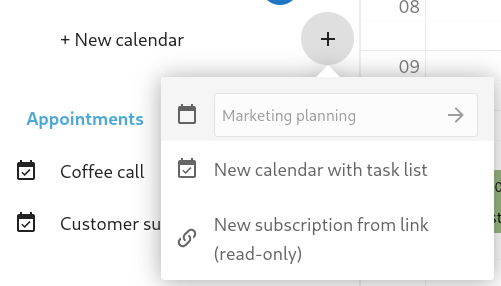
Import a Calendar
If you want to transfer your calendar and their respective events to your Nextcloud instance, importing is the best way to do so.
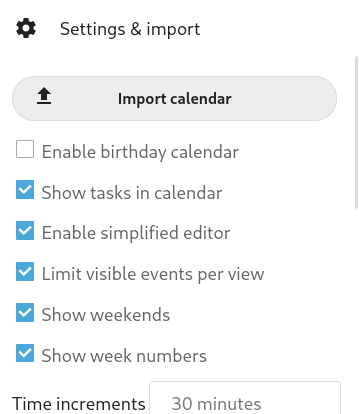
Click on the settings-icon labeled with
Settings & Importat the left-bottom.After clicking on
+ Import Calendaryou can select one or more calendar files from your local device to upload.The upload can take some time and depends on how big the calendar you import is.
Notitie
The Nextcloud Calendar application only supports iCalendar-compatible
.ics-files, defined in RFC 5545.
Edit, Export or Delete a Calendar
Sometimes you may want to change the color or the entire name of a previous imported or created calendar. You may also want to export it to your local hard drive or delete it forever.
Notitie
Please keep in mind that deleting a calendar is a irreversible action. After deletion, there is no way of restoring the calendar unless you have a local backup.
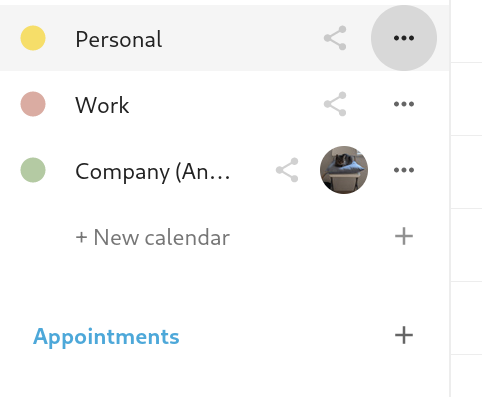
Click on the three-dot-menu of the respective calendar.
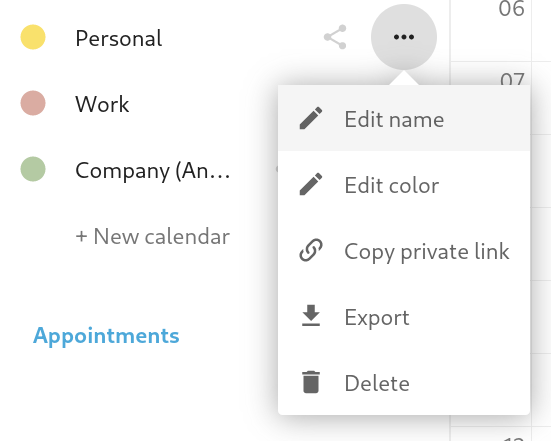
Click on Edit name, Edit color, Export or Delete.
Publishing a calendar
Calendars can be published through a public link to make them viewable (read-only) to external users. You may create a public link by opening the share menu for a calendar and clicking on « + » next to « Share link ». Once created you can copy the public link to your clipboard or send it through email.
There’s also an « embedding code » that provides an HTML iframe to embed your calendar into public pages.
Multiple calendars can be shared together by adding their unique tokens to the end of an embed link. Individual tokens can be found at the end of each calendar’s public link. The full address will look like
https://cloud.example.com/index.php/apps/calendar/embed/<token1>-<token2>-<token3>
To change the default view or date of an embedded calendar, you need to provide an URL that looks like https://cloud.example.com/index.php/apps/calendar/embed/<token>/<view>/<date>.
In this url you need to replace the following variables:
<token>with the calendar’s token,<view>with one ofmonth,week,day,listMonth,listWeek,listDay. The default view ismonthand the normally used list islistMonth,<date>withnowor any date with the following format<year>-<month>-<day>(e.g.2019-12-28).
On the public page, users are able to get the subscription link for the calendar and export the whole calendar directly.
Subscribe to a Calendar
You can subscribe to iCal calendars directly inside of your Nextcloud. By supporting this interoperable standard (RFC 5545) we made Nextcloud calendar compatible to Google Calendar, Apple iCloud and many other calendar-servers you can exchange your calendars with, including subscription links from calendar published on other Nextcloud instances, as described above.
Click on
+ New Subscriptionin the left sidebar.Type in or paste the link of the shared calendar you want to subscribe to.
Finished. Your calendar subscriptions will be updated regularly.
Notitie
Subscriptions are refreshed every week by default. Your administrator may have changed this setting.
Managing Events
Create a new event
Events can be created by clicking in the area when the event is scheduled. In the day- and week-view of the calendar you just click, pull and release your cursor over the area when the event is taking place.
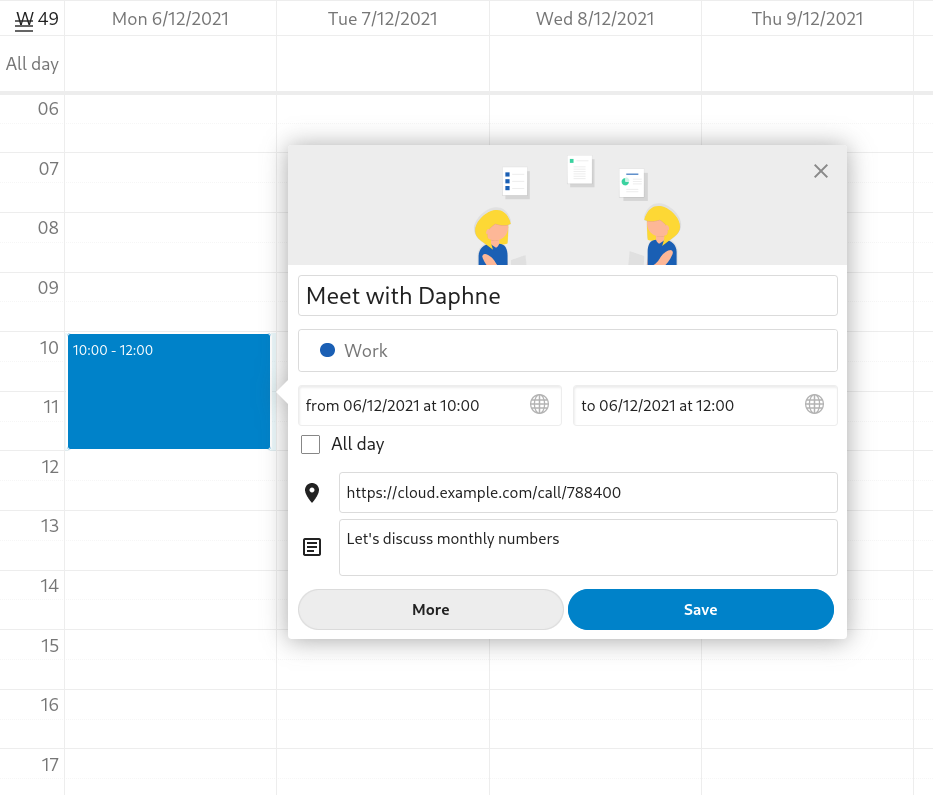
The month-view only requires a single click into the area of the target day.
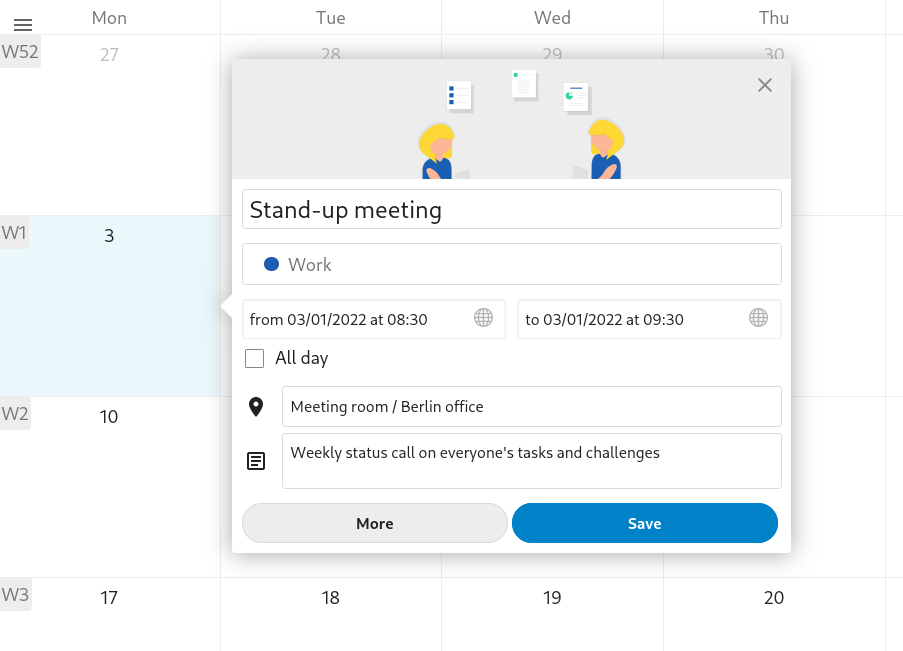
After that, you can type in the event’s name (e.g. Meeting with Lukas), choose the calendar in which you want to save the event to (e.g. Personal, Work), check and concretize the time span or set the event as an all-day event. Optionally you can specify a location and a description.
If you want to edit advanced details such as the Attendees or Reminders, or if you
want to set the event as a repeating-event, click on the More button to open the advanced
sidebar editor.
Notitie
If you always want to open the advanced sidebar editor instead of the
simple event editor popup, you can set a Skip simple event
editor checkmark in the Settings & Import section of the app.
Clicking on the blue Create button will finally create the event.
Edit or delete an event
If you want to edit or delete a specific event, you just need to click on it.
After that you will be able to re-set all event details and open the
advanced sidebar-editor by clicking on More.
Clicking on the Update button will update the event. To cancel your changes, click on the close icon on top right of the popup or sidebar editor.
If you open the sidebar view and click the three dot menu next to the event name, you have an option to export the event as an .ics file or remove the event from your calendar.
Tip
If you delete events they will go into your trash bin. You can restore accidentally deleted events there.
Invite attendees to an event
You may add attendees to an event to let them know they’re invited. They will receive an email invitation and will be able to confirm or cancel their participation to the event. Attendees may be other users on your Nextcloud instances, contacts in your address books and direct email addresses. You may also change the level of participation per attendees, or disable the email information for a specific attendee.
Tip
When adding other Nextcloud users as attendees to an event, you may access their free-busy information if available, helping you determine when the best time slot for your event is. Set your working hours to let others know when you are available. Free-busy information is only available for other users on the same Nextcloud instance.
Let op
Only the calendar owner can send out invitations. The sharees are not able to do that, whether they have write access to the event’s calendar or not.
Let op
The server administration needs to setup the e-mail server in the Basic settings tab, as this mail will be used to send invitations.
Assign rooms and resources to an event
Similar to attendees you can add rooms and resources to your events. The system will make sure that each room and resource is booked without conflict. The first time a user adds the room or resource to an event, it will show as accepted. Any further events at overlapping times will show the room or resource as rejected.
Notitie
Rooms and resources are not managed by Nextcloud itself and the Calendar app will not allow you to add or change a resource. Your Administrator has to install and possibly configure resource back ends before you can use them as a user.
Set up reminders
You can set up reminders to be notified before an event occurs. Currently supported notification methods are:
Email notifications
Nextcloud notifications
You may set reminders at a time relative to the event or at a specific date.
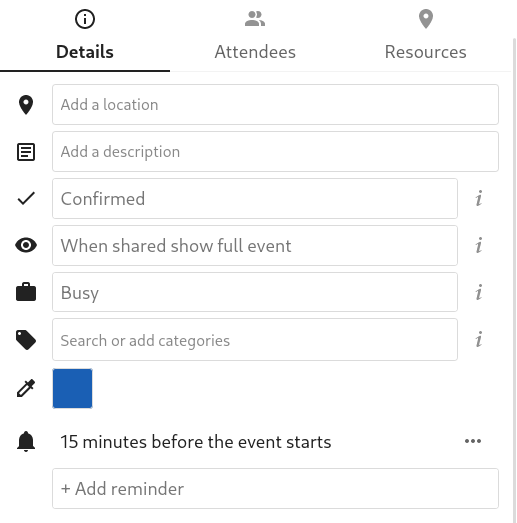
Notitie
Only the calendar owner and people or groups with whom the calendar is shared with write access will get notifications. If you don’t get any notifications but think you should, your Administrator could also have disabled this for your server.
Notitie
If you synchronize your calendar with mobile devices or other 3rd-party clients, notifications may also show up there.
Add recurring options
An event may be set as “recurring”, so that it can happen every day, week, month or year. Specific rules can be added to set which day of the week the event happens or more complex rules, such as every fourth Wednesday of each month.
You can also tell when the recurrence ends.
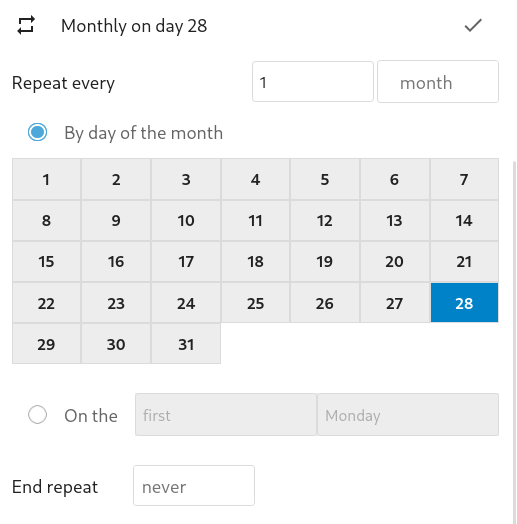
Trash bin
If you delete events, tasks or a calendar in Calendar, your data is not gone yet. Instead, those items will be collected in a trash bin. This offers you to undo a deletion. After a period which defaults to 30 days (your administration may have changed this setting), those items will be deleted permanently. You can also permanently delete items earlier if you wish.
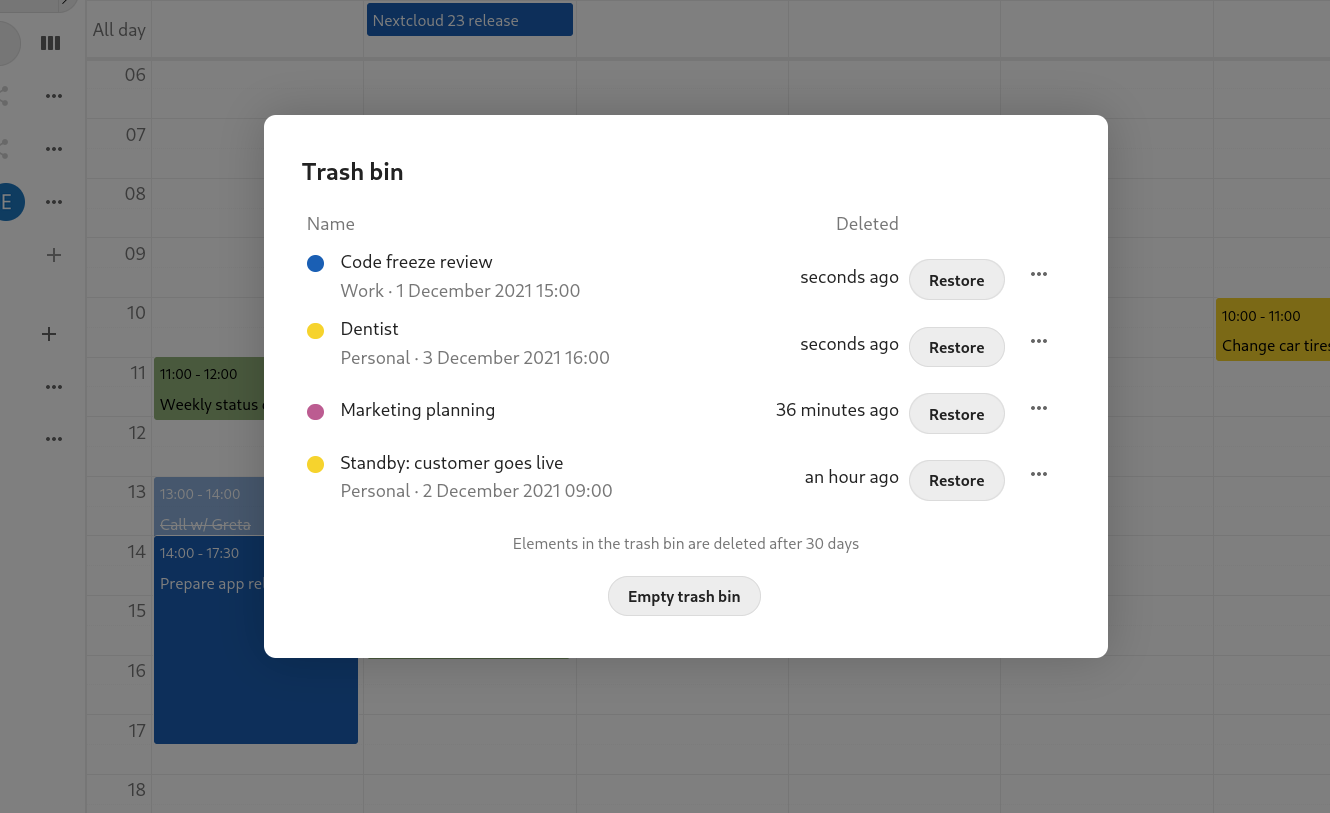
The Empty trash bin buttons will wipe all trash bin contents in one step.
Tip
The trash bin is only accessible from the Calendar app. Any connected application or app won’t be able to display its contents. However, events, tasks and calendars deleted in connected applications or app will also end up in the trash bin.
Responding to invitations
You can directly respond to invitations inside the app. Click on the event and select your participation status. You can respond to an invitation by accepting, declining or accepting tentatively.
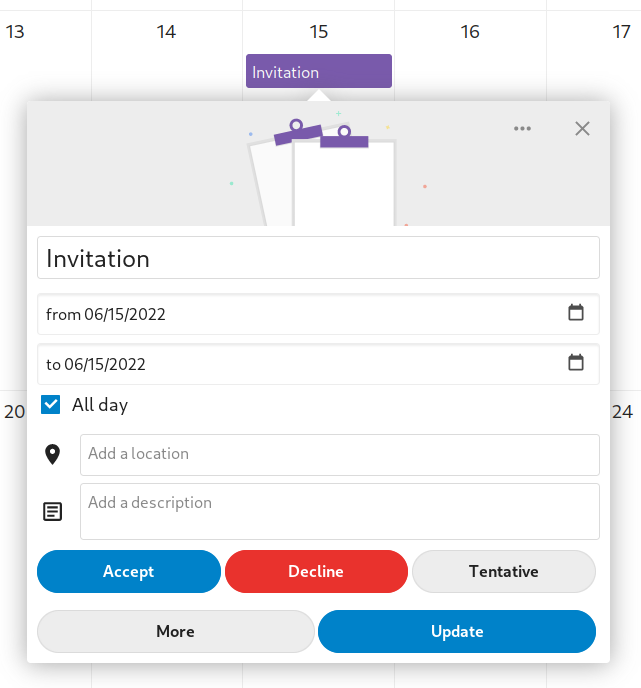
You can respond to an invitation from the sidebar too.
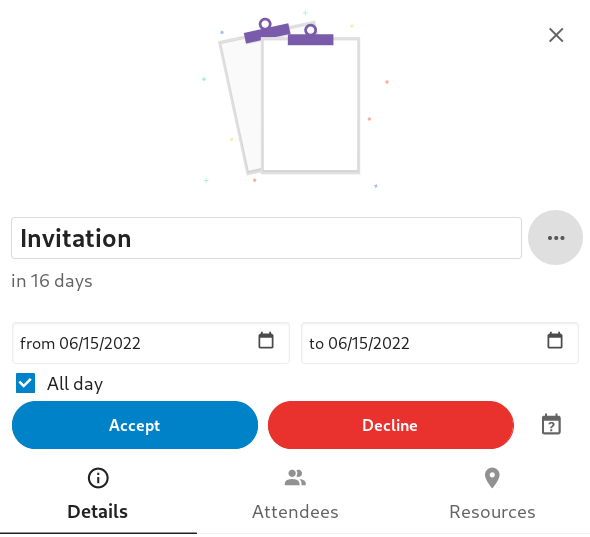
Availability (Working Hours)
The general availability independent of scheduled events can be set in the groupware settings of Nextcloud. These settings will be reflected in the free-busy view when you schedule a meeting with other people in Calendar. Some connected clients like Thunderbird will show this data as well.
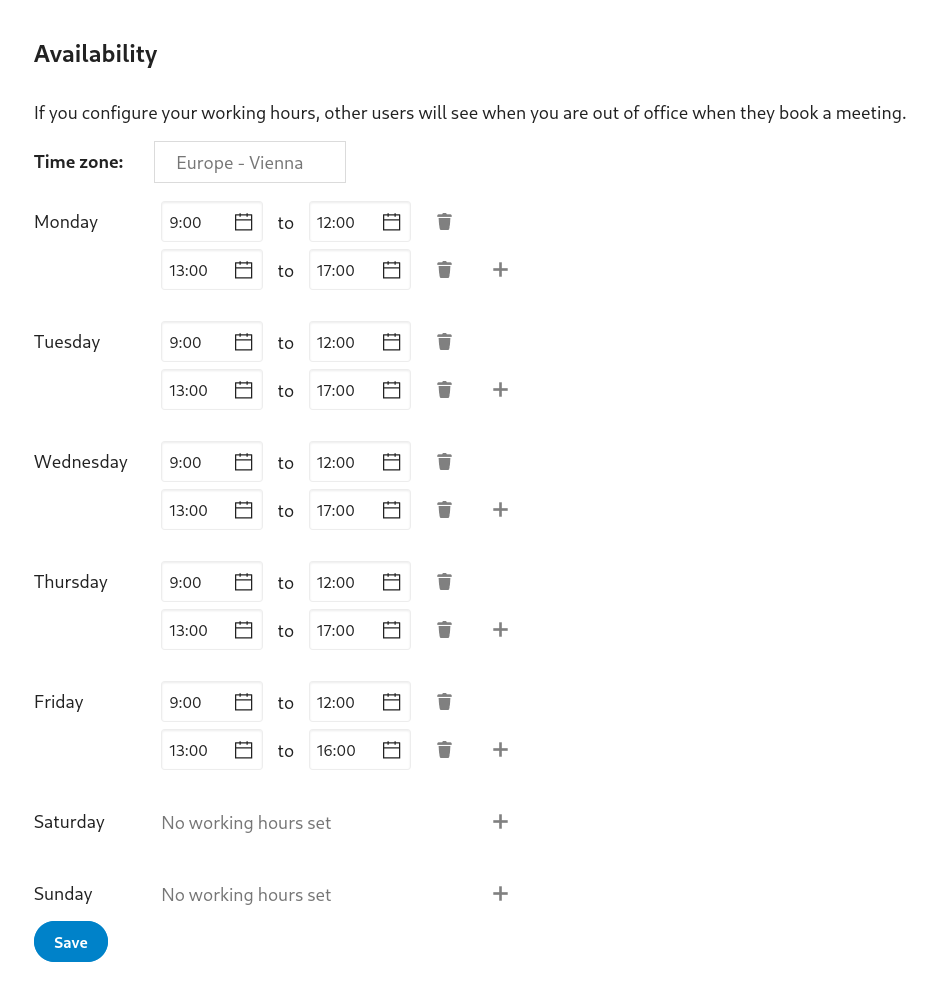
Birthday calendar
The birthday calendar is a auto-generated calendar which will automatically fetch the birthdays from your contacts. The only way to edit this calendar is by filing your contacts with birthday dates. You can not directly edit this calendar from the calendar-app.
Notitie
If you do not see the birthday calendar, your Administrator may have disabled this for your server.
Appointments
As of Calendar v3 the app can generate appointment slots which other Nextcloud users but also people without an account on the instance can book. Appointments offer fine-granular control over when you are possibly free to meet up. This can eliminate the need to send emails back and forth to settle on a date and time.
In this section we’ll use the term organizer for the person who owns the calendar and sets up appointment slots. The attendee is the person who books one of the slots.
Creating an appointment configuration
As an organizer of appointments you open the main Calendar web UI. In the left sidebar you’ll find a section for appointments, were you can open the dialogue to create a new one.
One of the basic infos of every appointment is a title describing what the appointment is about, e.g. “One-on-one” when a user wants to offer colleagues a personal call. The duration of the appointment can be picked from a predefined list. Next, you can set the desired increment. The increment is the rate at which possible slots are available. For example, you could have one hour long slots, but you give them away at 30 minute increments so an attendee can book at 9:00AM but also at 9:30AM. Optional infos about location and a description give the attendees some more context.
Every booked appointment will be written into one of your calendars, so you can chose which one that should be. Only slots that do not conflict with existing events in your calendars will be shown to attendees.
Appointments can be public or private. Public appointments can be discovered through the profile page of a Nextcloud user. Private appointments are only accessible to the people who receive the secret URL.
The organizer of an appointment can specify at which times of the week it’s generally possible to book a slot. This could be the working hours but also any other customized schedule.
Some appointments require time to prepare, e.g. when you meet at a venue and you have to drive there. The organizer can chose to select a time duration that must be free. Only slots that do not conflict with other events during the preparation time will be available. Moreover there is the option to specify a time after each appointment that has to be free.
To prevent an attendee from booking too short notice it’s possible to configure how soon the next possible appointment might take place.
Setting a maximum number of slots per day can limit how many appointments are possibly booked by attendees.
The configured appointment will then be listed in the left sidebar. You can copy its link and share it with the target attendees, or let them discover your public appointment via the profile page.
Booking an appointment
The booking page shows an attendee the title, location, description and length of an appointment. For a selected day there will be a list with all the possible time slots. On days with no available slots, too many conflicts or a reached daily maximum limit of already booked appointments, the list might be empty.
For the booking users have to enter a name and an email address. Optionally they can also add a comment.
To verify that the email is valid, a confirmation email will be sent. Only after clicking the confirmation link from the email the appointment booking will be finished. Until then the time slot might also be booked by another user who confirms their booking earlier. The system will detect the conflict and offer to pick a new time slot.
Working with the booked appointment
Once the booking is done, the organizer will find an event in their calendar with the appointment details and the attendee. As with any other event that has attendees, changes and cancellations will trigger a notification to the attendee’s email.
If attendees wish to cancel the appointment they have to get in contact with the organizer, so that the organizer can cancel or even delete the event.
